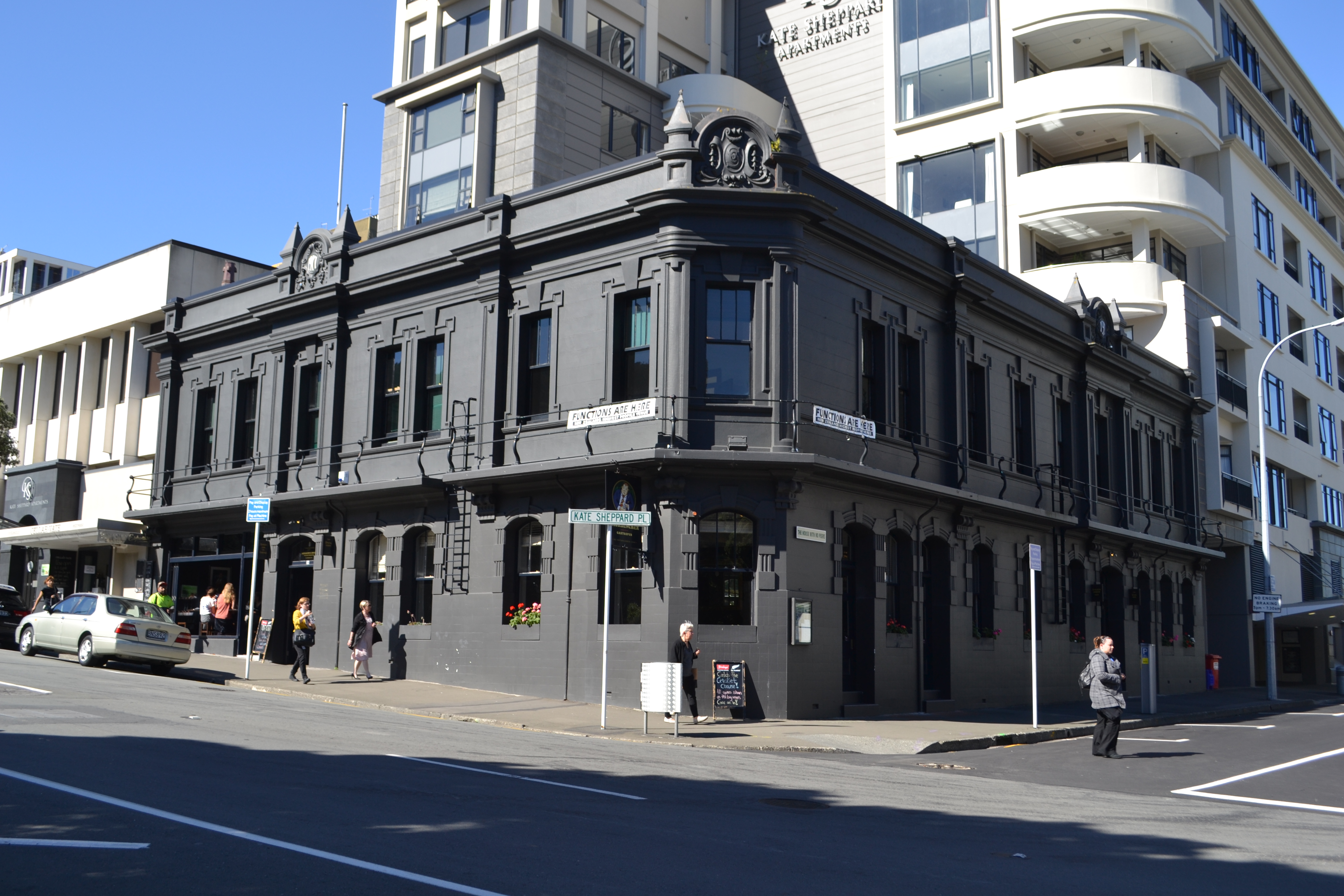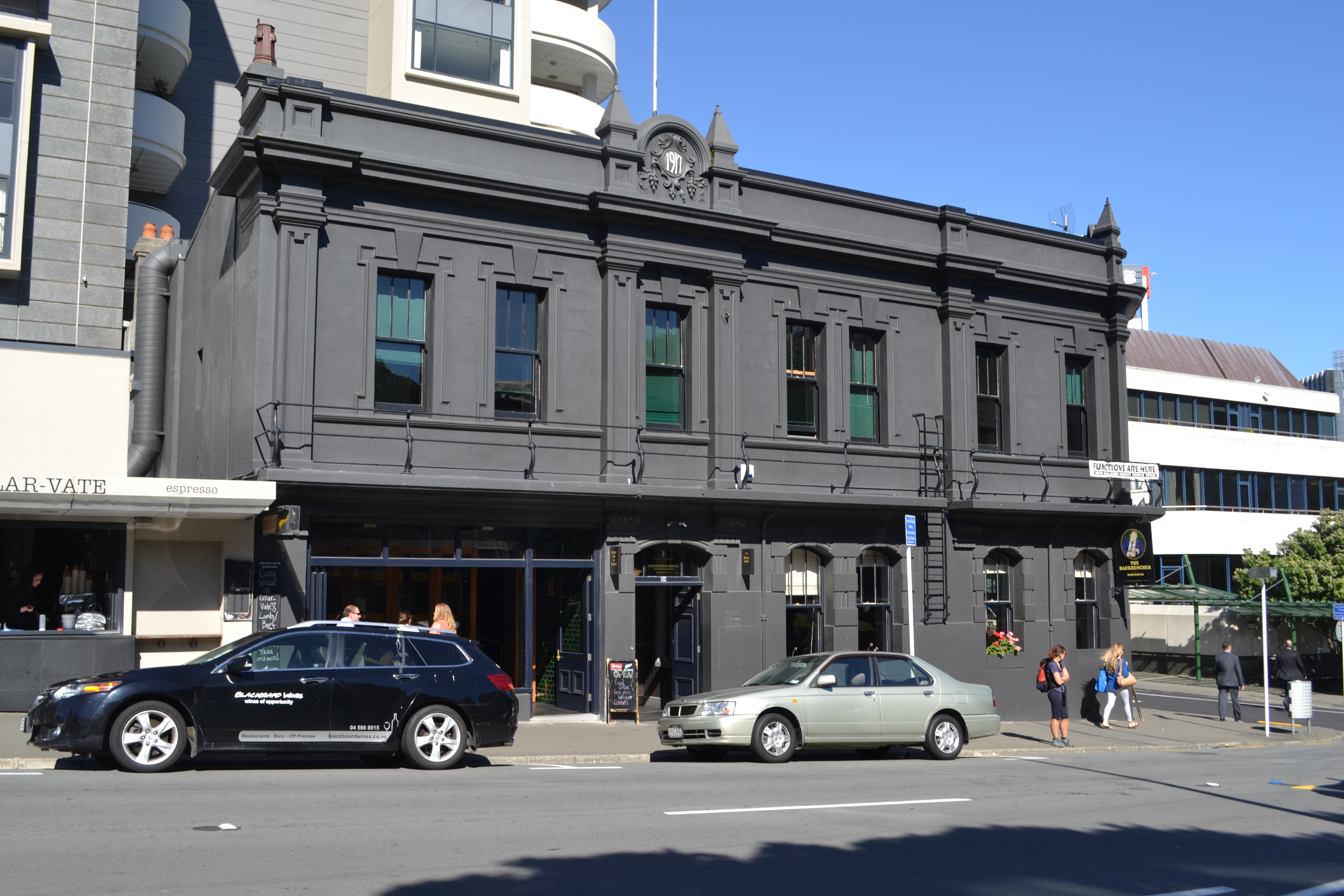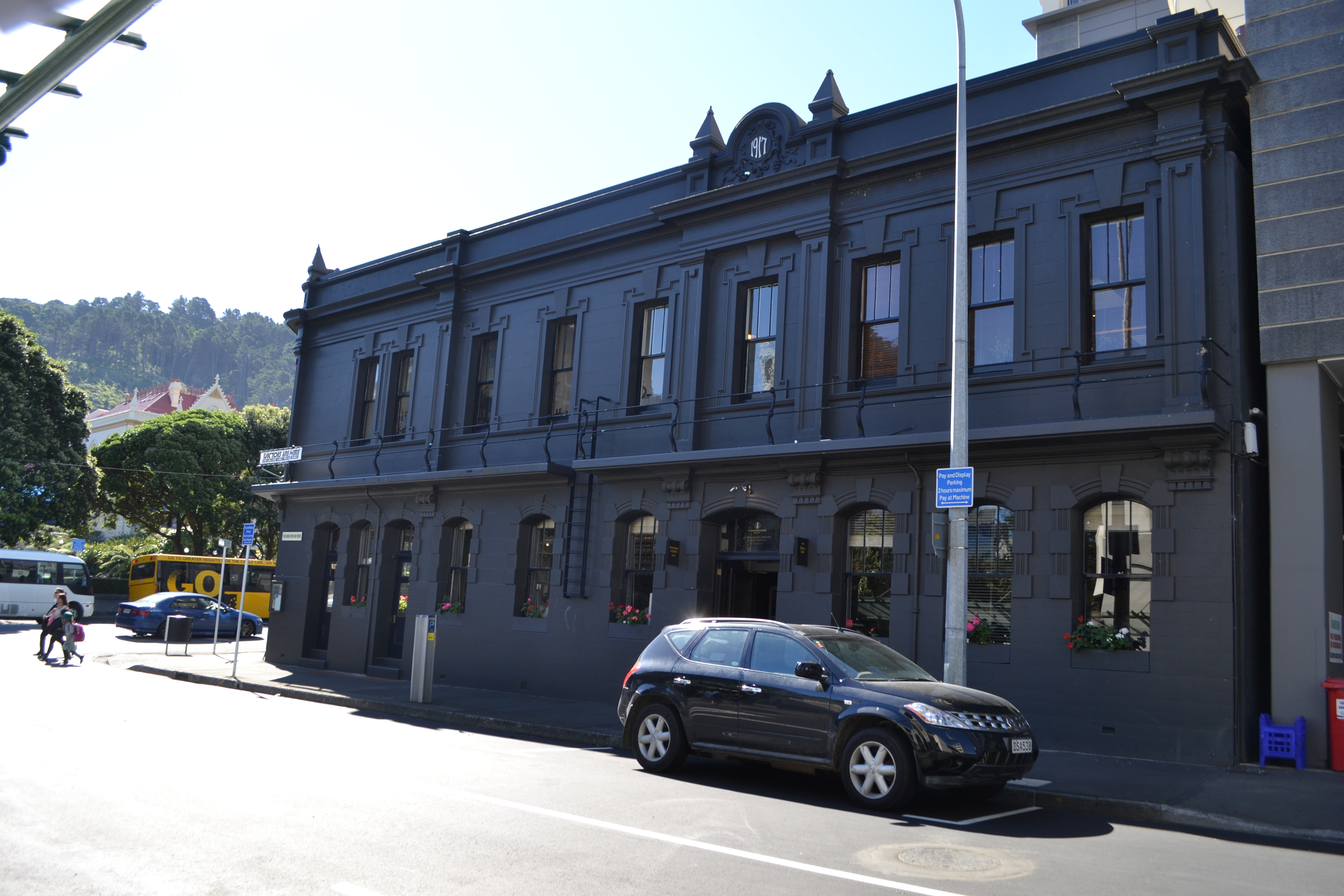Backbencher Pub and Cafe
Wellington Hotel, The Unofficial Bellamy’s
-
Constructed
1912 - 1917
-
-
Architect(s)
-
Builder(s)
Swan and Swan
-
This building is a well-designed Edwardian corner pub designed by notable Wellington architects Swan, and Swan and Swan.
It occupies a prominent corner site on the corner of Molesworth Street and Kate Sheppard Place and sits on the cusp of the Parliamentary Precinct Heritage Area, a historically important part of the city.
The hotel was owned and operated by the major Wellington brewery of Staples & Co. (later part of New Zealand Breweries). It also has a close association with parliamentarians and staff who have frequented the establishment for generations.
The building has rarity value as one of Wellington’s oldest masonry hotels, the facades of which are relatively unmodified.
-
Downloadable(s)
-
close
History
-
This building occupies a site long associated with hotels. The ‘Wellington Hotel’, a timber structure, was built on the property in 1869. The fabric of that hotel became part of the story of the present building.
The first Wellington Hotel occupied both sides of the corner site with the two arms of the building forming a courtyard at the back. The building was built, or later bought, by prominent brewers J. Staples and Co., whose brewery was a short distance up Molesworth St. The hotel’s close proximity to Parliament made it a popular drinking hole for parliamentarians and officials alike.
In 1912, the brewers undertook a major addition to the building. It was designed by architect John S. Swan and constructed by contractors Jones and Cameron. This new addition, obscured from the road, was built of more permanent materials – concrete and brick and cost a total of £1454.
This hotel benefited from its location near the busy Thorndon Quay tram terminus, and its proximity to Parliament and the Staples’ owned brewery on Molesworth Street. It provided accommodation and sold a range of alcohol, and it is probable that that included the Staples and Co. brand of beer.
A fire early in the morning of 12 April 1917 destroyed the original timber building. Most escaped, but Patrick Twohill, a well-known local identity died in the blaze. The fire was believed to be caused by a cigarette or lighted match. The brick and mortar 1912 addition survived.
Later that year architects Swan and Swan prepared a design for J Staples and Co. to replace the section of the hotel that had been destroyed. This addition, like the previous one, was constructed of brick with concrete foundations by contractor P. Robinson.
For a half century after World War I, drinking at the Wellington Hotel was, as other in all Wellington pubs, characterised by the six o’clock closing of pubs, a regulation that led to the frantic swilling of beer in the half-hour after work. This changed when pubs’ opening hours were extended in 1967 and again in the 1980s. Drinking became less frenetic and it is probable that the ambiance of the drinking culture at the Wellington Hotel reflected this change.
The hotel’s link with Parliament was significant. Between debates politicians would gather at the pub and it earned the nickname the ‘Unofficial Bellamy’s’. MP Sir Maui Pomare was among those who made good use of the particularly fine billiard table.
Although it continued in use as a public house, the hotel stopped taking guests in the early 1970s. In 1990 Lion Nathan purchased the property and carried out extensive refurbishment to a design by Dunning Thornton Consultants. The work was completed in 1991 and it reopened as ‘the Backbencher’. It soon earned a reputation as one of Wellington’s best patronised inner city bars. It took advantage of its proximity to Parliament to develop a satirical theme to the pub’s décor. The interior was decorated with cartoons from well-known satarists Tom Scott and Trace Hodgson. Original polystyrene puppets of prominent political figures were aquired from the television comedy show, ‘Private Eye’, and some still adorn the walls. The pub’s menu is also a satirical take on current political events. Despite two more changes of ownership, the themed pub continues to operate.
‘Back Benches’, a New Zealand political interview show presented by Wallace Chapman and Damian Christie, began using the pub as a venue for their show when it began airing on TVNZ 7 in April 2008.
On 8 June 2012 a fire damaged the interior of the building. Several puppets were badly charred and the kitchen was gutted. A second fire four months later further caused damage, mainly to the interior. The owners intend to restore some of the surviving puppets and build more and reopen the pub in February 2013. (2012)
-
Modifications
close
-
1869
-
Construction of the first Wellington Hotel.
-
1912
-
The first major addition is made to the buildings to a design by Wellington architect John S. Swan for the brewing company J.S. Staples & Co. Ltd. The contractor was Jones and Cameron. Contract Price: £1454. (00053:170:9360)
-
1913
-
Alterations. (00053:174:9605)
-
1917
-
Fires destroys timber hotel, which is replaced by J.S. Staples and Co. in brick and concrete to a design by architects Swan and Swan. The contractor was P. Robinson. (00053:191:10524)
-
1954
-
Alterations.(00056:484:B36427)
-
1957
-
Cellar alterations. . (00058:42:C2094)
-
1958
-
Hotel alterations. (00058:77:C3815)
-
1969
-
Building alterations. (00058:603:C28311)
-
1990 - 1991
-
Dunning Thornton Consultants refurbishes the building. Work includes office partitions and business additions and alterations. (00059:406:E20824 and 00059:411:E20985)
-
1992
-
Sign. (00059:530:E24863)
-
1994
-
More refurbishment. (00060:103:3781)
-
2002
-
Seismic strengthening. (00078:1085:95268)
-
2003
-
Internal alterations to café and bar. (00078:1161:104431)
-
2012
-
8th June - A fire destroys the kitchen and guts the interior.
-
unknown
-
3rd October – A second fire damages the interior.
-
-
Occupation History
close
-
1912
-
Wellington Hotel.
-
1990
-
The Backbencher.
-
-
-
close
Architectural Information
-
Building Classification(s)
close
Not assessed
-
Architecture
close
This is a well designed and carefully proportioned two storey Edwardian corner pub constructed of brick masonry. The façade consists of segmentally-arched windows on the ground floor and square-headed windows on the first floor. The window and door surrounds are rendered in plaster and treated, on the ground floor, as a shallow Gibbs surround (alternate squares and vertical stripes). The first-floor windows have a surround with square corners and an exaggerated keystone. A metal balcony runs the length of the façade at first-floor level. String courses run above the upper windows, and the building is capped with a plain entablature, projecting cornice, and a parapet that is built up over the corner and above the two main street entrances with a round crest and two short pinnacles.
-
Materials
close
Construction is load-bearing brick masonry on concrete foundation and piles. Internal partitions and window joinery are timber, with tongue and groove floors and pressed-metal ceilings. Note that there has been extensive internal refurbishment and the status of the floor is unclear.
-
Setting
close
The Backbencher occupies a conspicuous location adjacent to the Parliamentary Precinct Heritage Area. It sits amidst a row of major Government buildings, including the High Court and Appeal Court and National Library. Directly opposite is the large open space of Parliament grounds, with its statuary, trees, and a backdrop of nationally significant heritage buildings – Parliament Buildings, the Executive Wing (the Beehive) and the Parliamentary Library. The own hotel’s backdrop is less distinguished, with several large neighbours overshadowing the building, including the Kate Sheppard Apartments and Environment House.
-
Building Classification(s)
close
-
close
Cultural Value
This building is a well-designed Edwardian corner pub designed by notable Wellington architects Swan, and Swan and Swan.
It occupies a prominent corner site on the corner of Molesworth Street and Kate Sheppard Place and sits on the cusp of the Parliamentary Precinct Heritage Area, a historically important part of the city.
The hotel was owned and operated by the major Wellington brewery of Staples & Co. (later part of New Zealand Breweries). It also has a close association with parliamentarians and staff who have frequented the establishment for generations.
The building has rarity value as one of Wellington’s oldest masonry hotels, the facades of which are relatively unmodified.
-
Aesthetic Value
close
-
Architectural
Does the item have architectural or artistic value for characteristics that may include its design, style, era, form, scale, materials, colour, texture, patina of age, quality of space, craftsmanship, smells, and sounds?
The building is a well designed, carefully proportioned example of a two-storey Edwardian corner pub.
-
Group
Is the item part of a group of buildings, structures, or sites that taken together have coherence because of their age, history, style, scale, materials, or use?
The building is part of a group of early Wellington pubs which include The Thistle, The Tramway Hotel and The Shamrock.
-
Townscape
Does the item have townscape value for the part it plays in defining a space or street; providing visual interest; its role as a landmark; or the contribution it makes to the character and sense of place of Wellington?
The building occupies a prominent corner site and is one of the last remaining Edwardian buildings on Molesworth Street.
-
-
Historic Value
close
-
Association
Is the item associated with an important person, group, or organisation?
The hotel is historically associated with Staples and Co., Wellington’s biggest brewing company in the 19th and early 20th centuries and located a short distance north along Molesworth Street. It has had an association with generations of parliamentarians, and many still frequent it.
The earlier part of the building was designed by the well known Wellington architect John Swan, while the main building was the work of the successful partnership of Swan and Swan - the brothers Swan.
-
Association
Is the item associated with an important historic event, theme, pattern, phase, or activity?
The Backbencher is a surviving example of the corner pub, a place where Thorndonites and politicians could gather to drink and socialise.
-
-
Scientific Value
close
-
Archaeological
Does the item have archaeological value for its ability to provide scientific information about past human activity?
There was pre-1900 human activity on this site. Although part of the site has been altered by rebuilding or landscaping, there is potential archaeological value in the immediate area.
-
-
Social Value
close
-
Identity Sense Of Place Continuity
Is the item a focus of community, regional, or national identity? Does the item contribute to sense of place or continuity?
There has been a public house on this site since 1870 and the current Backbencher Pub, which evolved from the earlier timber hotel, contributes to the identity, sense of place and continuity of Molesworth Street.
-
Public Esteem
Is the item held in high public esteem?
The building was known to a national audience as the venue for the television show, ‘Back Benchers’ until June 2012.
-
-
Level of Cultural Heritage Significance
close
-
Authentic
Does the item have authenticity or integrity because it retains significant fabric from the time of its construction or from later periods when important additions or modifications were carried out?
The building facades to Molesworth Street and Kate Sheppard Place are relatively unmodified and retain substantial areas of original building fabric.
-
Local Regional National International
Is the item important for any of the above characteristics at a local, regional, national, or international level?
The building is of local importance.
-
Rare
Is the item rare, unique, unusual, seminal, influential, or outstanding?
This is a rare surviving example of an Edwardian building in Molesworth Street. It is also one of Wellington’s increasingly rare older public houses.
-
Representative
Is the item a good example of the class it represents?
The Backbencher is a good representative example of a traditional Wellington pub.
-
-
Local / Regional / National / International Importance
close
Not assessed
-
Aesthetic Value
close
-
close
Site Detail
-
District Plan Number
18/ 216 (Molesworth Street and Kate Sheppard Place facades)
-
Legal Description
Lot 2, DP318644
-
Heritage New Zealand Listed
2/Historic Place 1449
-
Archaeological Site
Central City NZAA R27/270
-
Current Uses
unknown
-
Former Uses
unknown
-
Has building been funded
No
-
Funding Amount
Not applicable
-
Earthquake Prone Status
SR Completed
-
-
close
Additional Information
-
Sources
close
- CT WN 157/246, Land Information New Zealand
- “Backbencher”, accessed June 2012,
- Historic Places Trust, “John Sydney Swan”, Professional Biographies. Accessed June 2012.
- Kernohan, David and Tony Kellaway. Wellington’s Old Buildings. Wellington: Victoria University Press, 1994.
- Lawlor, Pat. Old Wellington Hotels: Some History, Personalities and Anecdotes, Wellington: The Millwood Press, 1974.
- NZHPT, Buildings Classification Glossary of Architects, Engineers and Designers, NZHPT, unpublished, 1990.
- Phillips. Jock.”Culture and recreation in the city”, in Te Ara - the Encyclopedia of New Zealand. Updated September 28, 2011. Accessed June 20, 2012.
- Phillips, Jock.”Sports and leisure - Home and city”, in Te Ara - the Encyclopedia of New Zealand. Updated Jan 15, 2010. Accessed June 20, 2012,
- Stone’s Street Directories 1915-1940
- “Stuff.co.nz”, accessed 20 June 2012,
- Stuff.co.nz”, accessed 20 June 2012,
- Wellington City Council, “The Backbencher Pub and Cafe”, Wellington Heritage Building Inventory 2001: Non-Residential Buildings. Wellington City Council, 2001, MOLE3.
- Wises Street Directories, 1912 and 1990.
- ‘Board of Works’, Wellington Independent, Volume XXIV, Issue 2930, 18 December 1869.
- Fatal Fire”, Marlborough Express, Volume LI, Issue 85, 12 April 1917.
- ‘Political puppetry presides at the pub with no peer’, Evening Post, 17 August 1994.
- Wellington City Archives
- Corner Molesworth Street and Sydney Street [34 Molesworth Street], additions to the Wellington Hotel”, July29, 1912, 00053:170:9360,
- 34 Molesworth Street, alterations to the Wellington Hotel”, May 21, 1913, 00053:174:9605,
- Corner Molesworth Street and Sydney Street [34 Molesworth Street], rebuilding of the Wellington Hotel”, June 11, 1917, 00053:191:10524,
- “34 Molesworth Street, alterations hotel”, July 8, 1954, 00056:484:B36427,
- 34 Molesworth Street, cellar alterations”, November 13, 1957, 00058:42:C2094,
- 34 Molesworth Street, hotel alterations”, October 24, 1958, 00058:77:C3815,
- “34-38 Molesworth Street, building alterations”, Janurary 31, 1969, 00058:603:C28311,
- 34 Molesworth Street, office building – partitions”, 1990, 00059:406:E20824,
- “34 Molesworth Street, business additions and alterations”, 1990, 00059:411:E20985,
- 34 Molesworth Street, Backbenchers Tavern – sign”,1992, 00059:530:E24863,
- “34 Molesworth Street, refurbish offices”, February 22, 1994, 00060:103:3781,
- 34 Molesworth Street, seismic strengthening”, 2002, 00078:1085:95268,
- “34 Molesworth Street, internal alterations to cafe and bar”, 2003, 00078:1161:104431,
- Technical Documentation close
-
Footnotes
close
Not available
-
Sources
close
Last updated: 11/6/2017 3:52:41 AM



